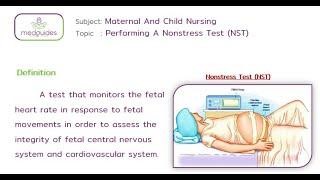Comparison with contraction stress test (CST)
Comparison with contraction stress test (CST) ( 5 Questions)
A nurse is preparing a client for a nonstress test (NST).
The nurse explains that this test will measure the FHR response to:
Uterine contractions are not the stimulus for FHR accelerations in a NST. Uterine contractions are used in a contraction stress test (CST), which measures the FHR response to uterine contractions induced by oxytocin or nipple stimulation.
Fetal movement. This is because a nonstress test (NST) measures the fetal heart rate (FHR) accelerations in response to fetal movement in a defined period of time. A reactive NST is when there are two or more FHR accelerations of at least 15 beats per minute for at least 15 seconds duration in a 20-minute period.
Oxytocin infusion is not used in a NST. Oxytocin infusion is another way of inducing uterine contractions for a CST.
Nipple stimulation is not used in a NST. Nipple stimulation is a natural way of inducing uterine contractions for a CST by releasing endogenous oxytocin.
Fetal movement. This is because a nonstress test (NST) measures the fetal heart rate (FHR) accelerations in response to fetal movement in a defined period of time. A reactive NST is when there are two or more FHR accelerations of at least 15 beats per minute for at least 15 seconds duration in a 20-minute period.
Choice A is wrong because uterine contractions are not the stimulus for FHR accelerations in a NST. Uterine contractions are used in a contraction stress test (CST), which measures the FHR response to uterine contractions induced by oxytocin or nipple stimulation.
Choice C is wrong because oxytocin infusion is not used in a NST. Oxytocin infusion is another way of inducing uterine contractions for a CST.
Choice D is wrong because nipple stimulation is not used in a NST. Nipple stimulation is a natural way of inducing uterine contractions for a CST by releasing endogenous oxytocin.

